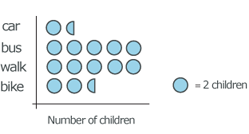Consolidation and practice
These resources are to support children in guided or independent work.
Opportunities to use and apply
Possible contexts include:
- real-life problems such as shopping activities, e.g. Work out what to buy and how to pay, find totals and give change.
- number problems and puzzles, e.g. I think of a number, double it and then add 5. The answer is 31. What was my number?
- interpreting graphs and charts, e.g. There are 31 children in this class. How many children are not represented on the pictogram?

- reading partly marked scales, e.g. Work out the difference between two labelled divisions, the number of intervals and the amount represented by each interval.

Confirming learning
Ask probing questions such as:
- How many steps will it take to solve this problem?
Three cups of orange juice are poured from a 1-litre carton. Each cup holds 200 ml. How much juice is left in the carton? Explain how you identified the steps and the calculations needed.
- What calculations will you do to find the number that lies halfway between 22 and 38?
What is the number represented by the question mark?

-
John wanted to use his calculator to add 463 and 319. He entered 263 + 319 by mistake. What could he do to correct his mistake?
- Add 200
- Add 2
- Subtract 2
- Subtract 200
 Calculating
Calculating


